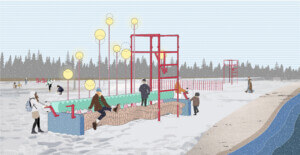Earlier this month, the Van Alen Institute announced Future Ground, an international design competition that is hoping to attract fresh strategies for reusing the many vacant lots that dot New Orleans. The competition is seeking submissions from landscape designers, architects, planners, public policy wonks, and pretty much anybody in the business of shaping urban environments and is supported by the New Orleans Redevelopment Authority (NORA), which owns more than 2,000 vacant lots.
There are somewhere around 30,000 empty lots and abandoned structures throughout New Orleans today, most of them left by Hurricane Katrina, which devastated the city in 2005. As the 10-year anniversary of the storm approaches, Future Ground is looking to create design and policy strategies capable of adapting to changes in density, demand, climate, and landscape in New Orleans over the next half-century in an effort to turn these abandoned landscapes into lasting resources.
NORA is currently working with New Orleans–based landscape architecture firm Spackman Mossop Michaels to develop land use strategies to reduce maintenance on many of its vacant lots. The firm’s principals, Elizabeth Mossop and Wes Michaels—along with Richard Campanella of Tulane University, Renia Ehrenfeucht and Marla Nelson of the University of New Orleans, and Allison Plyer of The Data Center—are serving on the competition’s Futures Team.
“Some of this land might not be developed for a long time. It’s important that the teams we select are not just looking at solutions for now, but for 10, 20, 50 years from now,” said Jerome Chou, director of competitions, Van Alen Institute. “They need to be flexible, accommodate future needs, changes in the climate, and shifting development pressures. That’s what the Futures Team is going to help us do. They will be working on potential scenarios of how the city might change over the next half century. It’s obviously not set in stone, but thinking through those scenarios can help us tell residents, government officials, and philanthropists ‘here’s what’s possible.'”
Winning teams will be selected from an international open RFQ process. Applications are due by September 29, 2014, and will be evaluated by a jury of local design and policy leaders, as well as representatives of other cities with land reuse problems of their own, including Dan Kinkead of Detroit Future City, and Terry Schwartz of the Cleveland Urban Design Collaborative.
Each winning team will be given a $15,000 stipend and will be asked to work closely in a six-month collaborative process with local stakeholders and national leaders. The goal is to bring small, incremental improvements to individual neighborhoods as well as the city as a whole; to develop policy that bolsters beneficial design strategies; and to make these strategies good enough to be sustained into the next generation. The Van Alen Institute will help out the selected teams to make up for the modest figure of the stipend by promoting their work nationally and internationally and developing networks.










